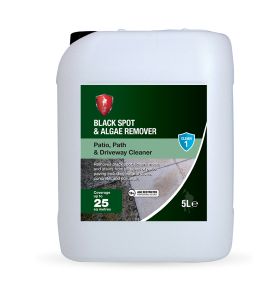
We’re really looking forward to spring, after one of the coldest and wettest winters on record - not to mention lock-down. Our patios, paths and driveways have taken a hit – and where there’s damp, there’s black spot. But, with the correct treatment, it’s something that can be remedied and halted in its tracks.
Black spot – which can be black or white - originates from plants and trees. It’s a dust-like lichen microspore carried by the wind and rain. It colonises on stonework, taking about 2-3 years to get really established below the surface. Black spot thrives in damp, shady places, sending its tendrils or ‘hyphae’ down into the stone’s pores, searching for nutrients. It’s a particular menace in porous stone, as its open texture enables the microspores to spread more easily, but even less porous materials like porcelain aren’t immune. Here, the lichen can still create a slippery residue on the tile surface.
Most people try to remove it with a pressure washer and, sometimes, a dose of household cleaner. This doesn’t work because hyphae become anchored into place below the surface. In fact, the extra dose of water only makes conditions even better for the rampant lichen. Also, pressure washing can damage the surface of the stone, loosen the grout and, if any protective sealer is applied, it will damage that too.
A specialist, two-pronged attack is necessary in order to remove black spot stains and the microspore colonises below the surface. Any treatment used needs to have a bleaching action, to restore the colour of the tile or paver. It also needs to target the hyphae below the surface. But care needs to be taken. If a treatment is acidic, it could damage acid sensitive material and erode the grout joint.

We’ve recently introduced a treatment called LTP Black Spot & Algae Remover that can be used on all types of natural stone, concrete, brick and porcelain. It removes organic residues – including black spot, lichen, moss and algae – shifting the surface stains and breaking down the hyphae below the surface, preventing regrowth. When applying the remover, it’s important to treat the whole area of paving, for a uniform appearance. It should also be left to act for the correct amount of time, so that it’s able to penetrate deep into the porosity of the stone, where the black spot has colonised; if these hyphae are left untreated, they will spread back to the surface and throughout the stone. A second treatment may be necessary if the black spot is really established. After treatment, it’s worth protecting the surface; we recommend LTP External Stone Sealer for natural stone and our new barrier treatment, LTP Porcelain Tile Protector, for matt porcelain pavers. Both will help prevent the absorption of moisture and organic particles, reducing staining and the spread of algae, mould and black spot – something that may become even more of a problem, as our winters warm up.

Patio, before and after treatment with LTP Black Spot & Algae Remover
To find out more, please visit http://www.ltp-online.co.uk. For further information, please contact LTP on tel. 01823 666213 or email [email protected]



